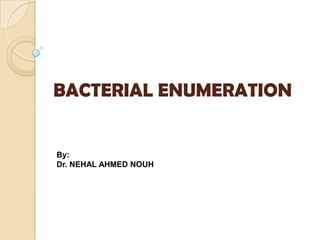
Nehal bacterial enumeration
- 1. BACTERIAL ENUMERATION By: Dr. NEHAL AHMED NOUH
- 2. There are numerous occasions when it is necessary to either estimate or determine the number of bacterial cells. Determination of cell numbers can be accomplished by a number of direct or indirect methods. The methods include: 1- The standard plate count. 2- Turbidity. 3- Direct microscopic counts.
- 3. I-Standard Plate Count (Viable Counts) A viable cell: Is defined as a cell which is able to divide and form a population (or colony). Indirect viable cell counts, also called plate counts: 1- A viable cell count is usually done by diluting the original sample. 2- Plating aliquots of the dilutions onto an appropriate culture medium. 3- Then incubating the plates under proper conditions so that colonies are formed. 4- After incubation, the colonies are counted and from a knowledge of the dilution used, the original number of viable cells can be calculated.
- 4. Materials 1- 6 tubes each containing 9.0 ml sterile saline. 2- 3 plates of suitable media. 3- 2 sterile 1.0 ml pipettes. 4- Pipette filler. 5- Turntable and bent glass rod. 6- Dish of alcohol. 1.0 Milliliter (ml) Pipette 7- Vortex.
- 5. Procedure A- Dilution of bacterial sample: The number of bacteria in a given sample is usually too great to be counted directly. If the sample is serially diluted and then plated out on an agar surface in such a manner that single isolated bacteria form visible isolated colonies. The number of colonies can be used as a measure of the number of viable (living) cells in that known dilution.
- 6. Dilution of Bacterial Sample, Step 1
- 7. Dilution of Bacterial Sample, Step 2
- 8. Dilution of Bacterial Sample, Step 3,4
- 9. Dilution of Bacterial Sample, Step 5,6
- 10. Normally, the bacterial sample is diluted by factors of 10 and plated on agar.
- 11. B- Plate out on agar surface: 1- Using a Pipette to Remove 2- Using a Vortex Mixer to Bacteria from a Tube. Mix Bacteria Throughout a Tube.
- 12. 3- Using a Pipette to Transfer 4- Using a Bent Glass Rod and a Bacteria to an Agar Plate. Turntable to Spread a Bacterial Sample.
- 13. C- Results after incubation: 1- Choose a plate that appears to have between 30 and 300 colonies. Sample 1/100,000 dilution plate (Figure a). Sample 1/1,000,000 dilution plate (Figure b). Sample 1/10,000,000 dilution plate (Figure c). 2- Count the exact number of colonies on that plate using the colony counter . 3- Calculate the number of CFUs per ml of original sample.
- 14. Results (Figure a) (Figure b) (Figure c)
- 15. For accurate determination of the total number of viable cells: The total number of viable cells is usually reported as Colony-Forming Units (CFUs) rather than cell numbers. A plate having 30-300 colonies is chosen because this range is considered statistically significant. If there are less than 30 colonies on the plate: small errors in dilution technique or the presence of a few contaminants will have a drastic effect on the final count. Likewise, if there are more than 300 colonies on the plate: there will be poor isolation and colonies will have grown together.
- 16. •To determine the number of CFUs per milliliter (ml) of sample: The number of CFUs per ml of sample = The number of colonies (30-300 plate) X The dilution factor of the plate counted Advantage: This method of enumeration is relatively easy to perform and is much more sensitive than turbidimetric measurement. Disadvantages: •A major disadvantage, however, is the time necessary for dilutions, platings and incubations, as well as the time needed for media preparation. •Only living cells develop colonies that are counted. •Clumps or chains of cells develop into a single colony. •Colonies develop only from those organisms for which the cultural conditions are suitable for growth.
- 17. II- Turbidity When you mix the bacteria growing in a liquid medium, the culture appears turbid. This is because a bacterial culture acts as a colloidal suspension that blocks and reflects light passing through the culture. Within limits, the light absorbed by the bacterial suspension will be directly proportional to the concentration of cells in the culture. By measuring the amount of light absorbed by a bacterial suspension, one can estimate and compare the number of bacteria present.
- 19. III- Direct Microscopic Count Petroff-Hausser counting chambers can be used as a direct method to determine the number of bacterial cells in a culture or liquid medium. In this procedure, the number of cells in a given volume of culture liquid is counted directly in 10-20 microscope fields. The average number of cells per field is calculated and the number of bacterial cells ml-1 of original sample can then be computed. Advantage of direct counts: Is the speed at which results are obtained. Disadvantage: Since it is often not possible to distinguish living from dead cells, the direct microscopic count method is not very useful for determining the number of viable cells in a culture.